Related Research Articles

The Tulsa race massacre, also known as the Tulsa race riot or the Black Wall Street massacre, was a two-day-long white supremacist terrorist massacre that took place between May 31 and June 1, 1921, when mobs of white residents, some of whom had been appointed as deputies and armed by city government officials, attacked black residents and destroyed homes and businesses of the Greenwood District in Tulsa, Oklahoma. The event is considered one of the worst incidents of racial violence in American history. The attackers burned and destroyed more than 35 square blocks of the neighborhood—at the time, one of the wealthiest black communities in the United States, colloquially known as "Black Wall Street."
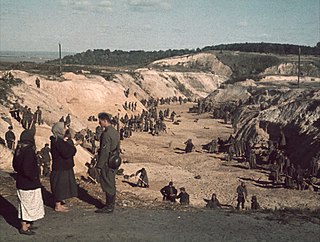
Babi Yar or Babyn Yar is a ravine in the Ukrainian capital Kyiv and a site of massacres carried out by Nazi Germany's forces during its campaign against the Soviet Union in World War II. The first and best documented of the massacres took place on 29–30 September 1941, in which some 33,771 Jews were murdered. Other victims of massacres at the site included Soviet prisoners of war, communists and Romani people. It is estimated that a total of between 100,000 and 150,000 people were murdered at Babi Yar during the German occupation.
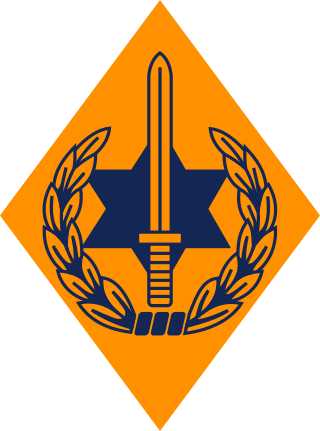
The 3rd "Alexandroni" Brigade is an Israel Defense Forces brigade which has fought in many of Israel's wars.
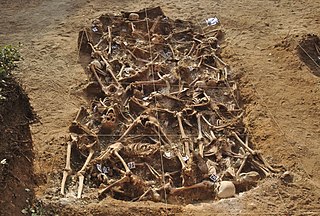
A mass grave is a grave containing multiple human corpses, which may or may not be identified prior to burial. The United Nations has defined a criminal mass grave as a burial site containing three or more victims of execution, although an exact definition is not unanimously agreed upon. Mass graves are usually created after many people die or are killed, and there is a desire to bury the corpses quickly for sanitation concerns. Although mass graves can be used during major conflicts such as war and crime, in modern times they may be used after a famine, epidemic, or natural disaster. In disasters, mass graves are used for infection and disease control. In such cases, there is often a breakdown of the social infrastructure that would enable proper identification and disposal of individual bodies.

Sonderaktion1005, also called Aktion1005 or Enterdungsaktion, was a top-secret Nazi operation conducted from June 1942 to late 1944. The goal of the project was to hide or destroy any evidence of the mass murder that had taken place under Operation Reinhard, the attempted extermination of all Jews in the General Government occupied zone of Poland. Groups of Sonderkommando prisoners, officially called Leichenkommandos, were forced to exhume mass graves and burn the bodies; inmates were often put in chains to prevent them from escaping.

The Le Paradis massacre was a World War II war crime committed by members of the 14th Company, SS Division Totenkopf, under the command of Hauptsturmführer Fritz Knöchlein. It took place on 27 May 1940, during the Battle of France, at a time when troops of the British Expeditionary Force (BEF) were attempting to retreat through the Pas-de-Calais region during the Battle of Dunkirk.
The Vukovar massacre, also known as the Vukovar hospital massacre or the Ovčara massacre, was the killing of Croatian prisoners of war and civilians by Serb paramilitaries, to whom they had been turned over by the Yugoslav People's Army (JNA), at the Ovčara farm southeast of Vukovar on 20 November 1991, during the Croatian War of Independence. The massacre occurred shortly after Vukovar's capture by the JNA, Territorial Defence (TO), and paramilitaries from neighbouring Serbia. It was the largest massacre of the Croatian War of Independence.

Katyn war cemetery is a Polish military cemetery located in Katyn, a small village 22 kilometres away from Smolensk, Russia, on the road to Vitebsk. It contains the remnants of 4,412 Polish officers of the Kozelsk prisoner of war camp, who were murdered in 1940 in what is called the Katyn massacre. Except for bodies of two Polish generals exhumed by German authorities in 1943 and then buried separately, all Polish officers murdered in Katyn were buried in six large mass graves. There is also a Russian part of the cemetery, where some 6,500 victims of the Soviet Great Purges of the 1930s were buried by the NKVD. The cemetery was officially opened in 2000.

The Srebrenica Genocide Memorial, officially known as the Srebrenica–Potočari Memorial and Cemetery for the Victims of the 1995 Genocide, is the memorial-cemetery complex in Srebrenica set up to honour the victims of the 1995 Srebrenica massacre. The victims—at least 8,372 of them—were mainly male, mostly Muslim Bosniaks and some Catholic Croats.

In Chechnya, mass graves containing hundreds of corpses have been uncovered since the beginning of the Chechen wars in 1994. As of June 2008, there were 57 registered locations of mass graves in Chechnya. According to Amnesty International, thousands may be buried in unmarked graves including up to 5,000 civilians who disappeared since the beginning of the Second Chechen War in 1999. In 2008, the largest mass grave found to date was uncovered in Grozny, containing some 800 bodies from the First Chechen War in 1995. Russia's general policy to the Chechen mass graves is to not exhume them.
The Korićani Cliffs massacre was the mass murder of more than 200 Bosniak and Bosnian Croat men on 21 August 1992, during the Bosnian War, at the Korićani Cliffs on Mount Vlašić in central Bosnia and Herzegovina.

The Vinnytsia massacre was the mass execution of between 9,000 and 11,000 people in the Ukrainian town of Vinnytsia by the Soviet secret police NKVD during the Great Purge in 1937–1938, which Nazi Germany discovered during its occupation of Ukraine in 1943. The investigation of the site first conducted by the international Katyn Commission coincided with the discovery of a similar mass murder site of Polish prisoners of war in Katyn. Among the 679 dead identified by the Germans in 1943, there were also a certain number of Russians and 28 Poles. Nazi propaganda invoked mention of the massacre to illustrate communist terror by the Soviet Union.

The Arnhem Oosterbeek War Cemetery, more commonly known as the Airborne Cemetery, is a Commonwealth War Graves Commission cemetery in Oosterbeek, near Arnhem, the Netherlands. It was established in 1945 and is home to 1,764 graves from the Second World War besides four later non-war graves and there are special memorials of two personnel buried elsewhere. Most of the men buried in the cemetery were Allied servicemen killed in the Battle of Arnhem, an Allied attempt to cross the Rhine in 1944, or in the liberation of the city the following year. Men killed in these battles are still discovered in the surrounding area even in the 21st century, and so the number of people interred in the cemetery continues to grow.

Donji Potočari is a village located in the municipality of Srebrenica, Republika Srpska, Bosnia and Herzegovina. As of 2013 census, the village has a population of 705 inhabitants.
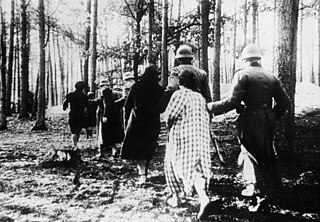
The Palmiry massacre was a series of mass executions carried out by Nazi German forces, during World War II, near the village of Palmiry in the Kampinos Forest northwest of Warsaw.
The Gračani massacre was the killing of several hundred prisoners of war of the Croatian Armed Forces and civilians in May 1945 in Gračani, a neighborhood of Zagreb, Croatia. The massacre was perpetrated by the Yugoslav Partisans after the end of World War II in Yugoslavia. As of September 2018, bodies of 295 victims were exhumed from the site.
Phoebe Stubblefield is an American forensic anthropologist specializing in human skeletal variation, human identification, and paleopathology. She is currently the Interim Director of the C.A. Pound Human Identification Laboratory at the University of Florida. She was formerly an associate professor at the University of North Dakota, where she also served as Chair of the Anthropology Department and Director of the Forensic Science Program. Her research integrates cultural anthropology and forensic science. She is currently leading efforts to locate and identify the remains of hundreds of victims of the 1921 Tulsa race massacre.
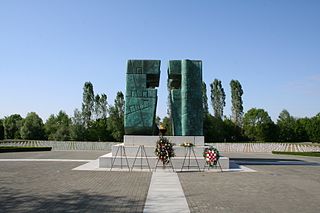
National Memorial Cemetery of The Victims of Homeland War in Vukovar is the largest mass grave in Croatia and in Europe after the Second World War, located on the eastern approach to Vukovar.
Oaklawn Cemetery is a cemetery in Tulsa, Oklahoma. To the north of the cemetery is 8th street, to the east is Peoria Avenue, to the south is 11th Street and to the west is highway 75. It is the oldest existing cemetery in Tulsa.
References
- ↑ C.L. Daniel profile. Retrieved 8-8-2024
- 1 2 3 Sutter, Sofia (12 July 2024). "First person identified in Tulsa massacre mass grave". NBC News . Retrieved 13 July 2024.
- 1 2 Burch, Audra D. S. (July 12, 2024). "The Search for Tulsa Massacre Victims Finally Reveals a Name". The New York Times . Retrieved July 13, 2024.
- ↑ Kemp, Adam (12 July 2024). "A World War I veteran is the 1st Tulsa Race Massacre victim to be identified in city's yearslong investigation". PBS News . Retrieved 13 July 2024.
- ↑ Falconer, Rebecca (11 November 2024). "1st Tulsa Race Massacre victim identified in mass grave honored with memorial". Axios . Retrieved 12 December 2024.